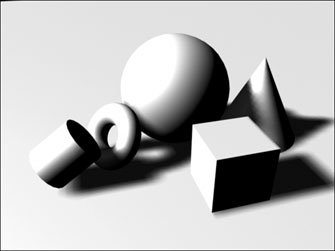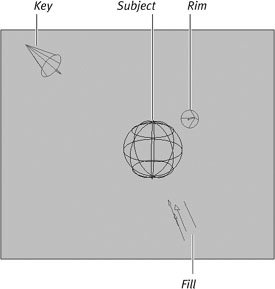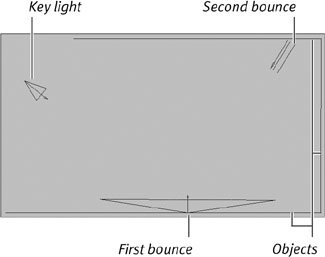About Lighting
| As we mentioned, light in the real world bounces from object to object, changing subtly and moving on. This means any given area is receiving light that is varied in intensity, energy, and direction. In Maya, light moves from a light object until it hits model geometry, where it stops. Light in Maya can acquire color from transparent objects, but other than that, it's up to you to fill in the missing behavior. As a result, most scenes include several different lights. In general, there is a light for every major visible source (bulbs, sun, moon, fires). Because the light from these sources doesn't illuminate the far side of the objects it hits, you need to create lights to fill in the dark areas (Figure 15.3). Usually, these lights are either ambient or dimmer lights pointing in the opposite direction from your primary lights. Your scene also may have areas that you simply want to be a bit brighterthose areas require their own lights, too. Figure 15.3. Even with very bright light, the far side of the objects remains pitch black. This unnatural look must be addressed with additional lights. Common rigsAs you can see, lighting in Maya can become fairly complicated. To help manage this, animators use a few general lighting strategies, commonly referred to as light rigs. Building one of these layouts of lights makes a good starting point for lighting your scene:
Light warmthBy default, all light in Maya is white. In the real world, light has a faint color (except, obviously, the colors in disco lights or stained glass and so forth). To approximate real life in Maya, you can assign a very faint color to your lights as well. Cool lights are white or light blue, and come from very high-energy sources (like the noon sun). They are best used for well-lit or hard, uncomfortable scenes such as a brightly lit laboratory. Warm lights are yellow, usually from lower energy sources like incandescent bulbs, fires, or sunrise/sunsets. You'd use warm lights for cozy, dimly lit scenes like candlelit dining rooms and country kitchens. Counterintuitively, the brighter or hotter the light source, the cooler the light appears visually. Light source temperatures are typically measured in degrees Kelvin. The following are common light temperatures:
|
EAN: 2147483647
Pages: 185



